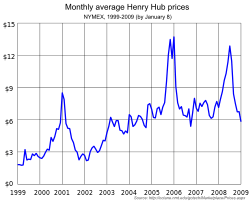Henry Hub
The Henry Hub is a distribution hub on the natural gas pipeline system in Erath, Louisiana, owned by Sabine Pipe Line LLC, a subsidiary of EnLink Midstream Partners LP who purchased the asset from Chevron Corporation in 2014.[2] Due to its importance, it lends its name to the pricing point for natural gas futures contracts traded on the New York Mercantile Exchange (NYMEX) and the OTC swaps traded on Intercontinental Exchange (ICE).

It interconnects with nine interstate and four intrastate pipelines: Acadian, Columbia Gulf Transmission, Gulf South Pipeline, Bridgeline, NGPL, Sea Robin, Southern Natural Pipeline, Texas Gas Transmission, Transcontinental Pipeline, Trunkline Pipeline, Jefferson Island, and Sabine. The two compressor stations can compress 520,000 decatherm/d (6.3 GW). The transportation capacity is 1.8 billion ft³/d (bcf) (590 m³/s) (20.4 GW).[3]
Spot and future natural gas prices set at Henry Hub are denominated in US$ per millions of British thermal units and are generally seen to be the primary price set for the North American natural gas market. North American unregulated wellhead prices are closely correlated to those set at Henry Hub.
History
The "Henry" hub is so named for its location in the Henry hamlet of Erath, which was named after the Henry High School that stood there until damaged by the flooding and storm surge from Hurricanes Ike[4] and Rita,[5] though the natural gas facilities suffered minimal damage.
This school was named for its benefactor, William Henry, who originally immigrated from Germany as Ludwig Wilhelm Kattentidt circa 1840,[6] and replaced his surname with Henry, taken from his father's middle name 'Heinrich'. There are Henry descendants in the area to this day. It was customary for benefactors to sponsor schools; there were other similarly sponsored schools in Vermilion Parish around that time.[7]
Henry Hub began operations during the early 1950s when Stone and Webster, Inc. built the original facility with unionized labor for The Texas Company (Texaco). The facility was manned by the International Union of Operating Engineers. In the 1960s, the Texas Company built and operated an adjoining facility, Sea Robin Plant,[8] without utilizing union labor based on right-to-work laws implemented in Louisiana.[9] By the 2000s, all of the unionized labor were replaced by contract laborers when Texaco and Chevron merged in October of 2000.[10][11]
NYMEX began offering standardized natural gas contracts with delivery at the Henry Hub in April 1990.
In 2011, the Henry Hub was the site of a land dispute, in which Sabine sued to condemn land near the site of their hub, and expropriate it from the Broussard family, who had owned it for generations, arguing that it was acting in the national interest.[12] The lawsuit was settled in 2012, and in 2013 a second, older, lawsuit was settled with Texaco (like Sabine, a Chevron company) for contamination of Broussard land which Texaco had leased for many decades.[13]
References
- http://octane.nmt.edu/gotech/Marketplace/year_prices.aspx?year=2009
- "EnLink to buy Chevron pipelines in Louisiana, Texas for $235 million". NOLA.com. Retrieved 2016-01-28.
- Sabine Pipe Line, LLC, 2000
- "Topic Report: Hurricane Ike Update". www.apachecorp.com. September 22, 2008. Archived from the original on October 12, 2008. Retrieved 2008-10-16.
- "The Disaster Center's Tropical Storm – Hurricane Rita Page". www.disastercenter.com. October 6, 2005. Retrieved 2008-10-16.
- Perrin, Warren A. (2011). Vermilion Parish. Mt. Pleasant, SC: Arcadia Pub. p. 27. ISBN 9780738582245. Retrieved 29 January 2014.
- Bodin, Stacy. "History of the Erath Schools". Vermilion Parish Schools. Archived from the original on 3 February 2014. Retrieved 29 January 2014.
- https://web.archive.org/web/20160109213124/http://data.rtknet.org/rmp/rmp.php?database=rmp&detail=3&datype=T&facility_id=100000175115
- https://web.archive.org/web/20160109213124/http://50.87.169.168/Documents/EPRN/Gumbo-Politics-unions-business-and-louisianaright-to-work-legistration.pdf
- https://www.nytimes.com/2000/10/16/business/chevron-agrees-to-buy-texaco-for-stock-valued-at-36-billion.html
- Personal Interview, Constant "Jack" LeBlanc, Abbeville, Louisiana, July, 1978, with Mike LeBlanc, participant in Projet Louisiane, an historical and ethnographic study funded by the Ford Foundation through York University, McGill University, and Universite de Laval. Archives of the project are located at the University of Louisiana at Lafayette, Center for Louisiana Studies.
- "Bitter Twist in Louisiana Family's Long Drilling Fight". New York Times. December 30, 2011. Retrieved 2011-12-30.
- "Broussard family from Henry settles lawsuit with Chevron over contaminated land at Henry Hub gas plant". The Vermillion Today. 2013-05-20. Archived from the original on 2014-03-10. Retrieved 2014-04-10.
External links
- Official website (enlink.com)
- NG Futures traded at CME/NYMEX
- Henry Hub Derivatives traded at ICE
- Energy Information Administration, Natural Gas Weekly Update Shows Henry Hub natural gas prices